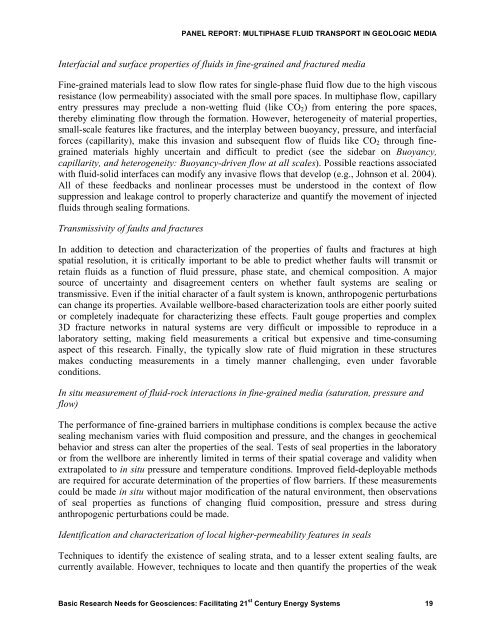Basic Research Needs for Geosciences - Energetics Meetings and ...
Basic Research Needs for Geosciences - Energetics Meetings and ...
Basic Research Needs for Geosciences - Energetics Meetings and ...
- No tags were found...
You also want an ePaper? Increase the reach of your titles
YUMPU automatically turns print PDFs into web optimized ePapers that Google loves.
PANEL REPORT: MULTIPHASE FLUID TRANSPORT IN GEOLOGIC MEDIAInterfacial <strong>and</strong> surface properties of fluids in fine-grained <strong>and</strong> fractured mediaFine-grained materials lead to slow flow rates <strong>for</strong> single-phase fluid flow due to the high viscousresistance (low permeability) associated with the small pore spaces. In multiphase flow, capillaryentry pressures may preclude a non-wetting fluid (like CO 2 ) from entering the pore spaces,thereby eliminating flow through the <strong>for</strong>mation. However, heterogeneity of material properties,small-scale features like fractures, <strong>and</strong> the interplay between buoyancy, pressure, <strong>and</strong> interfacial<strong>for</strong>ces (capillarity), make this invasion <strong>and</strong> subsequent flow of fluids like CO 2 through finegrainedmaterials highly uncertain <strong>and</strong> difficult to predict (see the sidebar on Buoyancy,capillarity, <strong>and</strong> heterogeneity: Buoyancy-driven flow at all scales). Possible reactions associatedwith fluid-solid interfaces can modify any invasive flows that develop (e.g., Johnson et al. 2004).All of these feedbacks <strong>and</strong> nonlinear processes must be understood in the context of flowsuppression <strong>and</strong> leakage control to properly characterize <strong>and</strong> quantify the movement of injectedfluids through sealing <strong>for</strong>mations.Transmissivity of faults <strong>and</strong> fracturesIn addition to detection <strong>and</strong> characterization of the properties of faults <strong>and</strong> fractures at highspatial resolution, it is critically important to be able to predict whether faults will transmit orretain fluids as a function of fluid pressure, phase state, <strong>and</strong> chemical composition. A majorsource of uncertainty <strong>and</strong> disagreement centers on whether fault systems are sealing ortransmissive. Even if the initial character of a fault system is known, anthropogenic perturbationscan change its properties. Available wellbore-based characterization tools are either poorly suitedor completely inadequate <strong>for</strong> characterizing these effects. Fault gouge properties <strong>and</strong> complex3D fracture networks in natural systems are very difficult or impossible to reproduce in alaboratory setting, making field measurements a critical but expensive <strong>and</strong> time-consumingaspect of this research. Finally, the typically slow rate of fluid migration in these structuresmakes conducting measurements in a timely manner challenging, even under favorableconditions.In situ measurement of fluid-rock interactions in fine-grained media (saturation, pressure <strong>and</strong>flow)The per<strong>for</strong>mance of fine-grained barriers in multiphase conditions is complex because the activesealing mechanism varies with fluid composition <strong>and</strong> pressure, <strong>and</strong> the changes in geochemicalbehavior <strong>and</strong> stress can alter the properties of the seal. Tests of seal properties in the laboratoryor from the wellbore are inherently limited in terms of their spatial coverage <strong>and</strong> validity whenextrapolated to in situ pressure <strong>and</strong> temperature conditions. Improved field-deployable methodsare required <strong>for</strong> accurate determination of the properties of flow barriers. If these measurementscould be made in situ without major modification of the natural environment, then observationsof seal properties as functions of changing fluid composition, pressure <strong>and</strong> stress duringanthropogenic perturbations could be made.Identification <strong>and</strong> characterization of local higher-permeability features in sealsTechniques to identify the existence of sealing strata, <strong>and</strong> to a lesser extent sealing faults, arecurrently available. However, techniques to locate <strong>and</strong> then quantify the properties of the weak<strong>Basic</strong> <strong>Research</strong> <strong>Needs</strong> <strong>for</strong> <strong>Geosciences</strong>: Facilitating 21 st Century Energy Systems 19
















